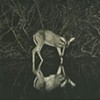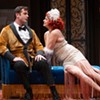Published September 21, 2005 at 1:35 p.m.
By the dawn of the 20th century, man's restless exploration of the globe's most remote reaches had left just one giant blank on the map: the continent of Antarctica. While the search for the Northwest Passage gave a tenuous commercial reason for charting the northern polar regions, the race to the South Pole was a pure "because-it's-there" quest for glory.
History remembers the Antarctic expeditions by the names of the men who led them: Scott, Amundsen, Shackleton. Irish actor and playwright Aidan Dooley reminds us that these leaders succeeded or failed on the backs -- quite literally -- of other men whose stories are equally compelling. Dooley's captivating one-man show about Tom Crean, who played a key role in three of the four major British tries at the South Pole, is back for a second run at the Briggs Opera House in White River Junction.
Dooley weaves a masterful evening of old-fashioned Irish storytelling, replete with clever digs at the English and cheeky admonitions to the audience. He so completely embodies his character that it feels like you're hearing the feisty adventurer spin his own yarns.
Before launching into the meat of Crean's story, Dooley vividly describes the extreme conditions polar travelers faced. He also dresses the part, wearing not much more than layers of long johns and wind-resistant, cotton Burberry overclothes. From where the ships landed, a roundtrip to the South Pole was an 1800-mile journey on foot -- the equivalent of walking from Dublin to Moscow, he points out. In winter, temperatures plunged so low that metal shattered like glass, and boiling water poured from a mug froze before hitting the ground.
Act I covers how an Irish farm boy from County Kerry ended up in a tent with the legendary explorer Robert Falcon Scott, just 145 miles shy of the South Pole. Tom Crean (1877-1938) -- no relation, as far as I know, although my maternal grandmother came from the neighboring town on the remote Dingle Peninsula -- ran away at 15 to join the British Royal Navy because of a fight with his father.
Dooley recounts the story, possibly apocryphal, of how Tom mistakenly put the family cows in the wrong field, leading to a unintended bovine potato pig-out. Papa Crean was furious over the crop loss. In the heat of the argument, Tom threatened to run away. Pride forced him to keep his word.
Crean wound up on Scott's first polar expedition, the Discovery (1901-04), because the commander found himself shorthanded in New Zealand, his last stop before Antarctica. Crean's levelheadedness and physical strength proved invaluable to Scott, and Crean was one of the first men Scott requested from the navy for his second Antarctic expedition, the Terra Nova (1910-13).
A spare set design kept the evening's focus entirely on the tales of adventure. A large wooden sledge, the key mode of transporting supplies across the Antarctic ice, was mounted on the black curtain behind the stage. Unlike the Norwegians, who used dogs to pull the sledges, the British relied primarily on man-hauling. Laying down depots of stores along the route to the pole was critical to an expedition's success, and consumed much of its time and manpower. A big part of Crean's value on the ice was his tireless sledging.
Dooley straps on a harness -- just a few bands of cotton webbing -- to demonstrate the brutal technique. Four men, roped together, pulled 800 pounds of cargo for up to 14 hours a day. They had to keep their heads down against the biting wind; visibility was further restricted by the wooden goggles they wore to protect against snow blindness and layers of headgear. ("Body heat and good ideas go out through your head," Dooley observes.) The lead man used a pole to probe the terrain ahead of him, looking for crevasses hidden by a thin crust of ice or snow.
Crean was one of eight men on the British expedition that landed on the polar plateau in January 1912, just 145 miles short of the goal. Scott refused to look Crean in the eye when he informed him he wasn't part of the final team -- a group of five, rather than the usual four. Although this decision probably saved Crean's life, Dooley gives the impression that Crean felt forever wronged by it, and left open an intriguing question: had Scott taken the fitter, hardier Crean, might Scott himself have lived?
When Scott reached the pole, he found that Norwegian Roald Amundsen had beaten him by a month. Scott's party froze to death on the return journey.
Down a man from the normal four-man sledging group, Crean's party barely survived their 750-mile return trip. Ravaged by scurvy, Teddy Evans, an officer with navigational training, became so weak that he had to be loaded on the sled. Evans ordered Crean and Bill Lashly to leave him to die and save themselves, but they refused. With only scraps of food remaining and Evans hovering near death, Crean set out on a solo march. He covered the last 35 miles to base camp in 18 hours, fueled by a few squares of chocolate, in time to get a rescue team to Evans and Lashly.
Amazingly, this was not Crean's narrowest escape, nor his most astounding tale of survival.
In Act II Dooley recounts Crean's voyage with Ernest Shackleton on the Endurance (1914-16). In 1909, Shackleton had come within 90 miles of the South Pole, but turned back because the health of his men was deteriorating and he calculated they might not be able to make the return trip safely. "Isn't it better to be a live donkey than a dead lion?" Shackleton quipped on his return to England.
The mission of the Endurance expedition was a transcontinental trek, and the commander had already selected Crean as one of the men to walk 1800 miles across the bottom of the globe with him. But the ship became lodged in the pack ice before it could make landfall, and after the ice crushed the ship, 28 men began one of the most harrowing and improbable journeys of survival ever recorded.
They camped on drifting, grinding floes of pack ice as Shackleton strategized about how to use three small lifeboats to reach an island where the crew might be rescued by passing whalers. Dooley leavens the saga of the epic escape with humor, mimicking the leopard seals and killer whales that lurked around the floes, putting inattentive crew members in danger of being mistaken for tasty penguins. But he also gives graphic examples of the extreme hardships. After wearing the same clothes for two years, the men's skin was so chafed that boils erupted on contact with sea water.
The crew eventually reached the uninhabited Elephant Island, an unforgiving outcropping far from any ship traffic. Taking the largest lifeboat -- all of 22 feet long -- Shackleton, Crean and four others sailed 800 miles across the gale-whipped South Atlantic. They navigated using a few brief sightings of the sun, and managed to hit their target, South Georgia Island, on the shore opposite the whaling station. Shackleton, Crean and another crew member then hiked over 30 miles of uncharted mountains and glaciers, with crampons fashioned from screws hammered into their boots.
After 36 hours of hiking, rappelling and sliding, they stumbled into Stromness, smelly bedraggled ghosts who had long been given up for dead. Dooley depicts how Shackleton immediately and frantically turned his attention to saving the rest of his men, sending urgent telegraphs around the world in search of rescue ships.
He succeeded. All 28 men from the Endurance survived.
In addition to providing a spellbinding evening of entertainment, Tom Crean: Antarctic Explorer is a remarkable essay on courage. Crean's heroism came quite literally from putting one foot in front of the other, no matter how terrifying, painful or hopeless the conditions may have been. There were any number of times Crean could have answered the seductive call of exhaustion or impending hypothermia -- "sleep, sleep. . ." -- especially on the long, lone march to save the lives of Evans and Lashly.
Dooley ascribes to Crean a combination of fierce determination and a fundamental optimism. A devout Catholic, Crean may have also seen the divine hand intervening at key moments. Dooley includes a few wry interludes of God and Mary looking down on Crean at opportune times, postponing a blizzard or guiding his careening glissade down a fog-shrouded, crevasse-riddled ice field.
In telling Crean's story, Dooley conveys the self-effacing modesty of the man from Kerry, who never wrote or gave interviews about his exploits. But Dooley also captures his remarkable selflessness. Crean was at his most courageous not when he was trying to save himself, but when the lives of other men depended on him.
More By This Author
Speaking of...
-

Executive Director Kurt Thoma Leaves Barre Opera House
Mar 5, 2024 -

Vermonter's Musical Bound for Broadway With Hillary Clinton as a Producer
Oct 25, 2023 -

Phantom Theater Finds New Winter Venue in Waitsfield
Oct 13, 2023 -

Double E 2023 Summer Concert Series Kicks Off With the Wailers
Mar 17, 2023 -

Off Center for the Dramatic Arts to Reopen in the New North End
Sep 23, 2022 - More »
Comments
Comments are closed.
From 2014-2020, Seven Days allowed readers to comment on all stories posted on our website. While we've appreciated the suggestions and insights, right now Seven Days is prioritizing our core mission — producing high-quality, responsible local journalism — over moderating online debates between readers.
To criticize, correct or praise our reporting, please send us a letter to the editor or send us a tip. We’ll check it out and report the results.
Online comments may return when we have better tech tools for managing them. Thanks for reading.













































